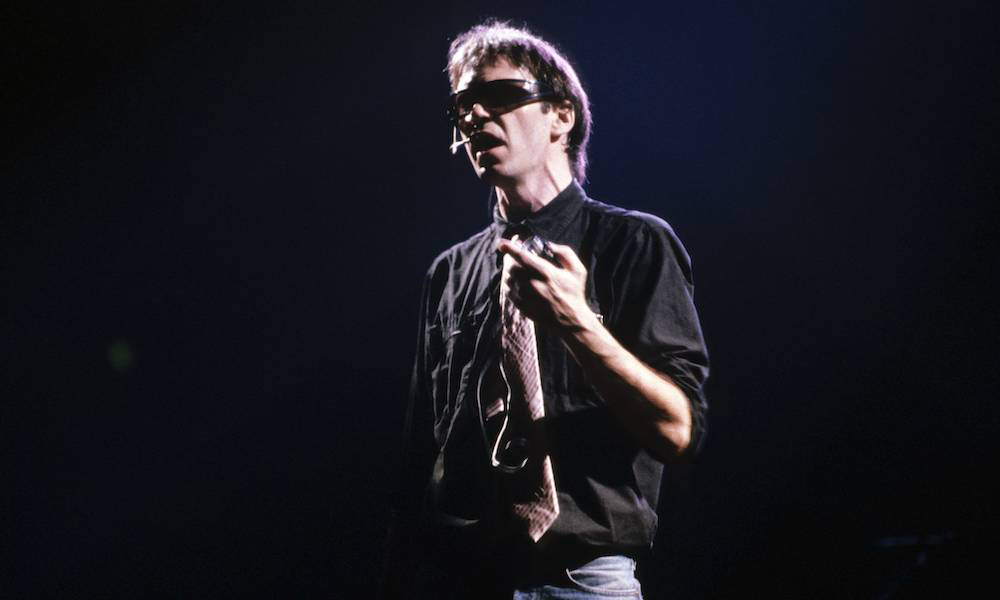Like many of the grunge musicians he went on to inspire, Neil Young has a conflicted relationship with his own success. “”Heart of Gold’ put me in the middle of the road. Traveling there soon became a bore, so I headed for the ditch,” he wrote in the liner notes to 1977’s greatest-hits album, Decade. “A rougher ride but I saw more interesting people there.” The three albums Young released after “Heart Of Gold” contain some of the darkest and most visceral songs he ever laid to tape, but the 80s were a rough ride for entirely different reasons, when Young released a string of experimental albums for Geffen Records.
In 1982, Young left his longtime label, Reprise, to join his friend David Geffen’s new, eponymous imprint. The five albums he released for Geffen are easily the most experimental in his discography, with Young swerving from one musical lane to the next. Yet there’s a lot to appreciate across these records, and their best moments serve as a reminder that while Young could be unpredictable in the studio, he was never uninspired.
Listen to the best of Neil Young’s Geffen Albums on Spotify and Apple Music.
Trans (1982): Entering the computer age
You could write a short book unpacking Trans’ backstory, but, in brief: Young’s son Ben was born with cerebral palsy, which left him unable to speak (among other things) and required him to spend nearly two years in therapy. Intrigued by the idea that his son could learn to communicate through technology – and inspired by bands like Devo and Kraftwerk – Young threw himself into a synthetic new sound, laying Synclavier overdubs on top of rock instrumentation and singing through a vocoder to symbolise his attempts to communicate with his son. The result is an album that sounds at once glossy and corroded, like a clear topcoat applied to a machine that has already rusted through.
Initially seen as a misstep at the time of its release, on 29 December 1982, Trans has aged beautifully – so much so that it no longer makes sense to call it an “underrated gem”. Its more raucous cuts, like “We R In Control” and “Computer Cowboy (AKA Syscrusher),” offer the same satisfying crunch as any Crazy Horse jam, while another song, “Sample And Hold,” splits the difference between Crazy Horse and Daft Punk. Even through a vocoder, Young’s plaintive tenor loses none of its emotive power, expressing the yearning at the heart of “Transformer Man” and “Mr. Soul.”
On the whole, Trans is an album about how technology was going to change – and has changed – the world we live in. But it’s “Little Thing Called Love” and “Hold Onto Your Love,” two of three holdovers from a scrapped project named Island In The Sun, that go back to Young’s therapy sessions with his son, as well as a theme he’s been writing about for his entire career: the power of love above all else.
Must hear: “Transformer Man”
Everybody’s Rockin’ (1983): A rockabilly shocker
While listeners and critics scratched their heads in response to Trans, the higher-ups at Geffen wrung their hands. In an attempt to get their musical maverick back on track, they stipulated that Young’s next release be a “rock’n’roll album”. The album they got, Everybody’s Rockin’, was in fact a rockabilly album, complete with the rich reverb and backing vocals that characterized the genre in the 50s, and was cut in a little over a month with a group of players Young christened The Shocking Pinks.
Taken on its own terms, Everybody’s Rockin’ is a fun blast from the past. Young faithfully recreates the rockabilly sound, and songs like the title track and “Kinda Fonda Wanda” would sound right at home on a jukebox. He and The Shocking Pinks also try their hand at a few covers – most notably Junior Parker’s “Mystery Train,” a song made famous by the original king of rock’n’roll, Elvis Presley.
Must hear: “Everybody’s Rockin’”
Old Ways (1985): Getting back to the country
Young had a version of Old Ways ready to go in 1983 but was forced to put it on hold in favor of his “rock’n’roll album”. He returned to the studio to make some adjustments to the record, adding some new songs and bringing in country music legends Waylon Jennings and Willie Nelson to sing along, before finally releasing the album on 12 August 1985.
While Young had recorded several albums in a country-rock style before (Harvest, Comes A Time, Hawks & Doves), Old Ways was (and remains) his furthest foray into pure country music – and he didn’t do it halfway, embellishing these songs with fiddles and even a Jew’s harp (the bouncy instrument you hear on “Get Back To The Country.”
As with Everybody’s Rockin’, the most compelling reason to listen to Old Ways is to hear Young throw himself headlong into a genre he isn’t known for. There are a few moments where he wanders a bit too far into melodramatic, string-laden territory, but then there are also some truly lovely moments, like “Are There Any More Real Cowboys?,” an ode to “country families” and the working men who support them (“Not the one/That’s snorting cocaine/When the honky-tonks all closed/But the one/That prays for more rain”), and “Bound For Glory,” in which two lonely travelers find love on the road. Let’s put it this way: if you’ve got a friend who loves country music and has never heard Neil Young, this wouldn’t be a bad introduction.
Must hear: “Are There Any More Real Cowboys?”
Landing On Water (1986): A return to rock
It’s hard to say what exactly Young was trying to accomplish with Landing On Water, which came out less than a year after Old Ways, on 21 July 1986. On one hand, it’s the most rock-oriented album that he released on Geffen, rocking even harder than his 1987 reunion with Crazy Horse, Life. But on the other hand, it sometimes feels more robotic and compressed than Trans.
That said, Landing On Water has its highlights. “Hippie Dream” is a bitter swipe at – you guessed it – hippie idealism, reserving some of Young’s sharpest barbs for former CSNY bandmate David Crosby (“Another flower child/Goes to seed”). “Touch The Night” is an anthemic, crushing number that ends with a guitar solo so thrilling that even the production does little to dampen it. And on “Pressure,” Young hits the same cold, brittle grooves that Joy Division and Gang Of Four used to build post-punk. It would be fascinating to hear a modern rock band try to bring Landing On Water’s retro-futuristic sound into the present.
Must hear: “Touch The Night”
Life (1987): Back in the saddle
Young’s trusty backing band, Crazy Horse, appeared on some parts of Trans, while many of the songs that would appear on Landing On Water were first attempted, unsuccessfully, with the group in 1984. In late 1986, Young brought the Horse on tour again, during which they performed several new songs live. Those songs would form the bulk of Life, released in July 1987 as Young’s final album for Geffen.
After four albums of genre experiments, Life marked Young’s return to no-nonsense rock. All but two songs were recorded in an amphitheater, and it sounds like it. The material is stronger, too, starting with “Mideast Vacation” and “Long Walk Home,” two sobering tracks that address America’s hawkish approach to foreign policy as well as its human cost.
Life has some majestic slow-burners, such as “Inca Queen” and “When Your Lonely Heart Breaks,” and some fierce barnburners like “Around The World” and the pointed “Prisoners Of Rock’n’Roll,” all of which transcend their 80s production and stand as some of the best songs Young wrote that decade. It’s hard to say if anyone in the audience might recognize these songs if Young were to perform them live today, but it would be thrilling to see him dust them off.
Must hear: “Around The World”
Aftermath: Chasing his muse
Young returned to Reprise in late 1987, but he wasn’t quite finished with genre-hopping experimentation. In 1988, he released This Note’s For You, in which he put together a new band, The Bluenotes (complete with a horn section), and tried his hand at blues-rock. He wasn’t finished with being an anti-commercial crank, either. That album’s title track is a vicious takedown of corporate-friendly artists who are all too happy to sign their songs over to advertisers. The song’s music video featured a Michael Jackson lookalike with burning hair, which drove Jackson to threaten legal action.
While it would be difficult to argue that Neil Young’s Geffen years saw him at his artistic peak, one can be certain that he was making exactly the kind of music he wanted to. When the label sued him for making music that was “uncharacteristic of [his] previous recordings”, they had lost sight of what made him a rock legend: his refusal to rest on his artistic laurels, and his willingness to chase his muse down every road it leads him. No doubt Young would have made it easier on himself if he’d been willing to pursue a more commercially viable path in the interest of selling more records, but he wouldn’t be Neil Young if he did.




